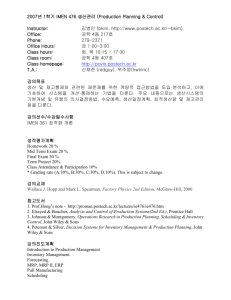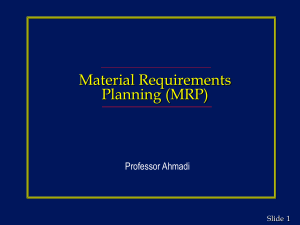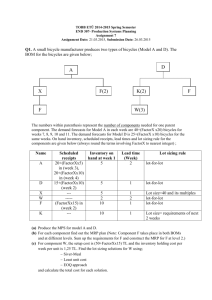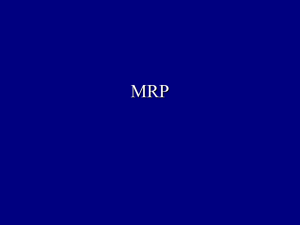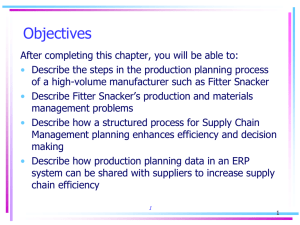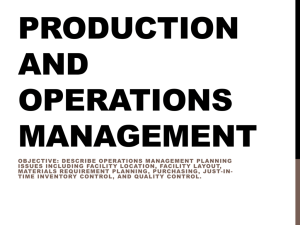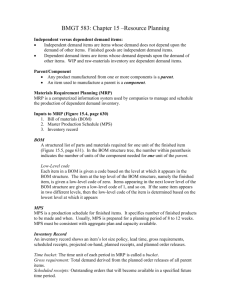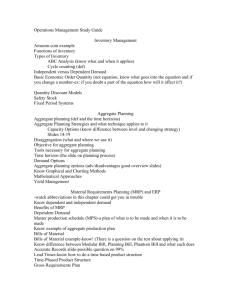Chapter 14 - Resource Planning
advertisement
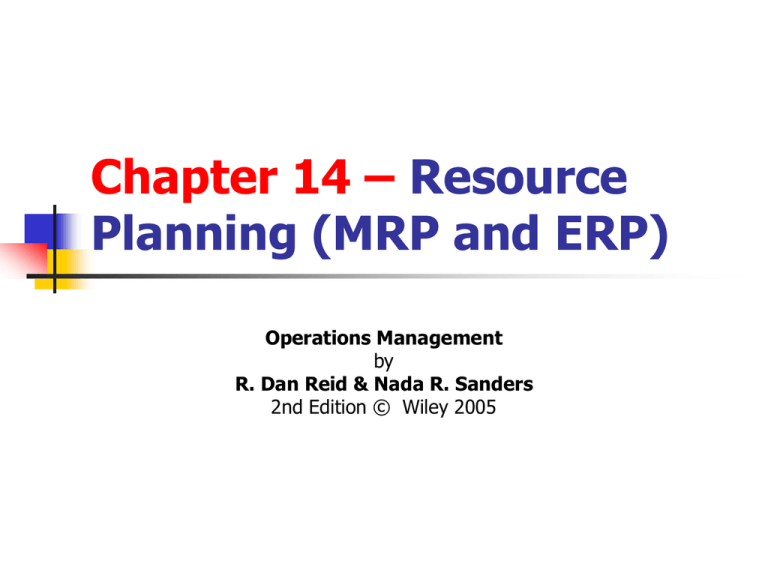
Chapter 14 – Resource Planning (MRP and ERP) Operations Management by R. Dan Reid & Nada R. Sanders 2nd Edition © Wiley 2005 Types of Demand There are two types of demand. Independent Demand Is the demand for finished products Does not depend on the demand of other products Needs to be forecasted Dependent Demand Is the demand derived from finished products Is the demand for component parts based on the number of end items being produced and is managed by the MRP system Evolution of Material Planning Systems Back in the sixties, manufacturing planning systems were reorder point systems that simply determined when and how much to order First MRP systems translated a master schedule of final products into time-phased net requirements for subassemblies, assemblies, and parts Closed-loop MRP included production planning, master scheduling, and capacity requirements In mid 1970’s, MRPII systems added functionality to plan and execute all internal functions An Overview of MRP MRP uses the concept of backward scheduling to determine how much and when to order and replenish The MPS module contains the authorized schedule The BOM module contains the product structure for each unique product The Inventory Record module keeps track of the inventory status for each item in the database MRP output includes schedules for all internal activities and parts as well as orders for all supply chain items Input/Output - MRP Process Objectives of MRP Determines the quantity and timing of material requirements Determines what to order (checks BOM), how much to order (lot size rules), when to place the order (need date minus lead time), and when to schedule delivery (on date needed) Maintain priorities In a changing environment, MRP reorganizes priorities to keep plans current and viable Building a CD Cabinet With MRP MRP Inputs - Authorized MPS From the authorized MPS, we calculate when we need to have replenishment orders of CD cabinets; when we need a new MPS order. Table 14-1 Initial MPS Record for CD Cabinet Item: CD Cabinet Lot size rule: FOQ=100 Lead time: 1 week Gross Requirements: Projected Available: MPS 80 1 25 55 2 25 30 3 25 5 4 25 -20 5 30 6 30 7 30 8 30 9 35 10 35 11 35 12 35 5 30 50 6 30 20 7 30 90 100 8 30 60 9 35 25 10 35 90 100 11 35 55 12 35 20 Table 14-2 Updated MPS Record for CD Cabinet Item: CD Cabinet Lot size rule: FOQ=100 Lead time: 1 week Gross Requirements: Projected Available: MPS 80 1 25 55 2 25 30 3 25 5 4 25 80 100 MRP Inputs-Inventory Records System checks the inventory record for each BOM item to see if inventory is available or if a replenishment order is needed to build the cabinets. Table 14-3 First Inventory Record for CD Cabinet Item: CD Cabinet Lot size rule: L4L Lead time: 1 week Gross Requirements: Scheduled Receipts: Projected Available: Planned Orders 0 1 0 2 0 3 0 4 100 0 0 0 -100 5 0 6 0 7 100 8 0 9 0 10 100 11 0 12 0 Table 14-4 Updated Inventory Record for CD Cabinet Item: CD Cabinet Lot size rule: L4L Lead time: 1 week Gross Requirements: Scheduled Receipts: Projected Available: Planned Orders 0 1 0 2 0 3 0 4 100 5 0 6 0 7 100 8 0 9 0 10 100 11 0 12 0 0 0 0 100 0 0 0 100 0 0 0 100 0 0 0 MRP Inputs-Bills of Material A BOM lists all of the items needed to produce one CD cabinet The BOM is exactly like a recipe for baking a cake The BOM’s must be complete and accurate and can only be changed by an ECN MRP BOM’s are indented bills of materials Indented BOM A Product Structure Tree The Inventory Record Item: LT: Lot Size: Gross Requirements Scheduled Receipts Projected Available Planned Orders 1 2 3 4 5 6 7 8 9 10 The MRP Explosion Process Table 14-6 Updated Inventory Record for CD Cabinet Item: CD Cabinet Lot size rule: L4L Lead time: 1 week Gross Requirements: Scheduled Receipts: Projected Available: Planned Orders: Parent: none Children: Top, bottom, door, left side, right side, shelves, shelf supports 0 1 0 2 0 3 0 4 100 5 0 6 0 7 100 8 0 9 0 10 100 11 0 12 0 0 0 0 100 0 0 0 100 0 0 0 100 0 0 0 Using this table and the product structure tree, we will work through an example of how the MRP explosion process calculates the requirements for building a CD cabinet. Next we start with the cabinet top to show how MRP calculates the gross requirements for this component. Inventory Records - Components It was noted on the previous slide that the parent item (CD Cabinet) has planned orders in periods 3, 6, and 9. Its children (top, bottom, door, left & right side, shelves, and supports) have gross requirements in periods 3, 6, and 9. Inventory Records - Components Inventory Records– Components con’t Inventory Records– Components con’t Inventory Records – Remaining Components Inv. Records – Remaining Components con’t Inv. Records – Remaining Components con’t MRP Explosion A Simplified Example CD Cabinet LT = 1 Cabinet Door Cabinet Side Usage = 2 Usage = 2 LT = 3 LT = 3 Hinge Screw Screw Usage = 2 Usage = 8 Usage = 2 LT =4 LT = 1 LT = 1 MRP Example Continued Master Production Schedule – Inventory Records – 100 CD Cabinets to be delivered in Periods 4, 7, and 10 On Hand: Door – 120, Side – 50, Hinge – 0, Screw – 600 On Order: Door – 216 due in period 2, Hinge 932 due in period 3. Lot Size Rules – CD Cabinets – Lot-for-lot, Door – FOQ 216, Side – FOQ 250, Hinge – FOQ 932, Screw – FOQ 2000 MRP Action Notices Action Notices: Indicate items that need a production planner’s attention Are created when a planned order needs to be released, due dates need to be adjusted, or when there is insufficient lead time for normal replenishment Often require planners to rush or expedite orders MRP Action Notices Action Bucket: Is the current period where we take actions such as releasing, rescheduling, or canceling orders A positive quantity in current period’s planned order row means that an order must be released Lot Sizing Rules Rules are used to change the frequency of replenishment orders & set the quantity of each order (balance holding & ordering costs to reduce total costs) Common rules: Fixed Order Quantity (FOQ) Lot-for-Lot (L4L) Periodic Order Quantity (POQ) Example Comparing Lot Size Rules: Three lot sizing rules used within MRP Systems are: fixed order quantity (FOQ), lot for lot (L4L), and period order quantity (POQ). Cost comparison is based on Inventory holding costs ($0.10/period) and ordering cost ($25/order). In this example POQ is best at $133.50. Rough Cut Capacity Example: The CRP module uses data from MRP. Calculate workloads for critical work centers based on open shop orders and planned shop orders. These shop orders are translated into hours of work by work center and by time period. Table 14-11 show items scheduled for work Center 101. Available = 4 machines x 2 shifts x 10 hours x 5 days x 0.85 utiliza- x 0.95 effiCapacity per shift per wk. tion ciency Available = 323.0 standard hours Capacity Workload Graph for Work Center 101: CRP enables a company to evaluate both the feasibility of the MRP system and how well the company is using its critical work centers. Enterprise Resource Planning What Is ERP? Software designed for organizing and managing business processes Modules share information across all business functions Can share customer sales data with the supply chain to help with global replenishment All modules are fully integrated and use a common database – some PC based Integration of ERP ERP Modules-4 Categories Finance and accounting Sales and marketing Handles pricing, availability, orders, shipments, & billing Production and materials management Investment, cost, asset, capital, and debt management Budgets, profitability analysis, and performance reports Process planning, BOM, product costing, ECN’s, MRP, allocates resources, schedules, PO’s, & inventory Human resources Workforce planning, payroll & benefits, & org. charts Benefits of ERP Implementation ERP presents a holistic view of the business functions from a single information and IT architecture Increases organizational information flow Increases ability to incorporate better management control, speedier decision making, and cost reductions Allows replacement of disparate systems e.g. ExxonMobile used ERP to replace 300 different systems A study of ERP implementations reports that benefits typically start 8 months after implementation with median annual savings of $1.6 million Cost and Implementation Issues Major suppliers are SAP, Peoplesoft, Oracle, and Baan. Also smaller PC based suppliers. Costs for larger ERP systems range from hundreds of thousands to several million dollars. Outside consultants are usually involved in selection, configuration, and implementation. Consultant costs can run up to 3 times the cost of the system itself according to a Gartner Group study. Added costs also include additional people, new computer hardware, and the cost to develop a new, integrated database Successful implementation requires leadership and top management commitment to a vision for the business Homework Problems 1 – 5, 11 – 18.
